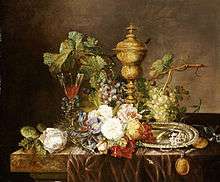Emily Coppin Stannard
Emily Coppin Stannard (1803–1885) was a British 19th century painter known for her still life work. She was one of only two notable women artists associated with the Norwich School, Britain's first provincial art movement.

Biography
Emily Coppin was born in 1803 in Norwich, England, the daughter of painter and collector Daniel Coppin, one of the founders of the Norwich Society of Artists (NSA).[1][2] Norwich was then England's second city, with a very active art community that included John Crome and John Sell Cotman.[3] The artists connected with the NSA became known as the Norwich School of painters; Emily was one of only two notable women artists associated with the Norwich School, the other being her niece Eloise Harriet Stannard.[2][3] Emily was trained by both her father and her mother, who was also an artist, and she would live and work in Norwich for most of her life.[1][4]
In 1826, already an established artist, she married the Norwich School painter Joseph Stannard, who died of tuberculosis four years later at the age of 33. Their daughter Emily (1827–94) would also become a painter, and when she reached adulthood she assisted her mother in the art teaching she did to supplement her income.[5]
Stannard traveled to Holland in 1820 to study Dutch painting, which greatly influenced her subsequent work.[1] Her typical subjects thereafter were realistically painted bouquets of flowers in vases and traditional still life paintings with tableware and fruit or game animals, set against monochrome backgrounds.[4] That same year, at the age of 17, she was awarded the Norwich Society of Artists' gold medal for one of her flower paintings.[1] She won again the following year for a fruit painting, and a third gold medal in 1828 for a still life of game animals.[1][6] Although she displayed her work mainly in Norwich, she also exhibited at the Royal Society of British Artists in 1824 and the British Institution (1823–25).[1] One of her paintings, Still Life of Dead Ducks, a Hare with a Basket and a Sprig of Holly (1853), hangs at Norwich Castle which has the largest collection of works by Norwich School artists.[3]
Stannard continued painting for over fifty years. She died on 6 January 1885.
In Stannard's day, still life painting was treated as a second-rate form by many art critics, who considered that it took skill but not imagination.[7] As the century progressed, this view was displaced by an understanding that still life painting at its best expressed truth to nature as well as any other subject.[7] Stannard is now considered one of the two finest British women still life painters of the century, the other being her niece Eloise.[5]
References
- 1 2 3 4 5 6 Gray, Sara. The Dictionary of British Women Artists. Lutterworth Press, 2009, p. 249.
- 1 2 Allthorpe-Guyton, Marjorie. "Norwich School of Artists". Norfolk Museums and Archaeology Service 1979, rev. 2003.
- 1 2 3 Ecclestone, Sue. "Art Lover's Delight - Cassone Art Online - Norwich School of Artists". Cassone The Online International Art Magazine, republished on EcclestoneArtHistory website, April 11, 2013. Accessed Dec. 14, 2015.
- 1 2 Vincent, Adrian. A Companion to Victorian and Edwardian Artists. David & Charles, 1992.
- 1 2 Walpole, Josephine. Art and Artists of the Norwich School. Antique Collectors Club Limited, 1997, pp. 58-59.
- ↑ Mackie, Charles. Norfolk Annals: A Chronological Record of Remarkable Events in the Nineteenth Century. Vol. 2 (1851–1900). Printed by the Norfolk Chronicle, 1901, p. 354.
- 1 2 Mühleisen, Susanne, et al. Eating Culture: The Poetics and Politics of Food. Universitätsverlag Winter, 2003, p.224.
